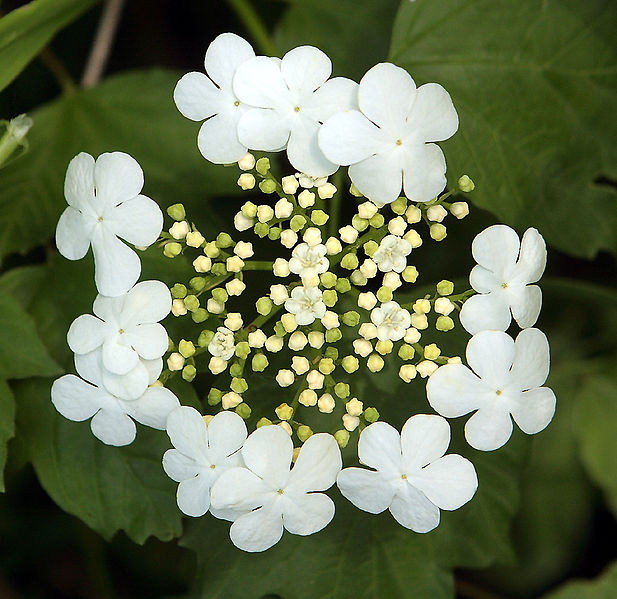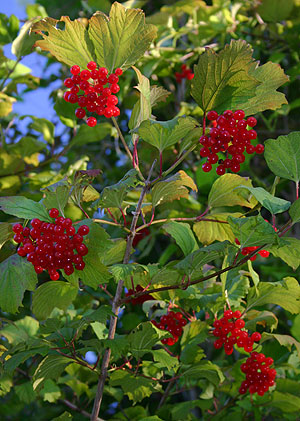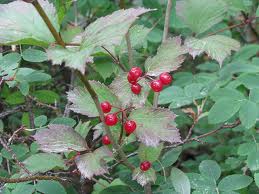I miss High Bush Cranberries. They don’t grow within a thousand miles of here, and they aren’t really cranberries. But they are hearty and familiar fare in northern climes.
The High Bush Cranberry is actually a Viburnum (Viburnum trilobum) and a cousin of the elderberry. Both are in the greater Honeysuckle Family and have a characteristic musky odor. That family by the way straddles the edibility line, with some members edible and others not, some tasty and some not. As one might suspect by the name, the High Bush Cranberry has tart fruit. Bradford Angier, a well-known Canada-based forager along side Euell Gibbons, wrote they require a “conditioned palate” to appreciate.
In North America the High Bush Cranberry is found in Canada and the northern half of the United States plus, oddly, New Mexico. It is not as that friendly to wildlife as one might suspect. The fruit persists into the winter because they are not on the top of birds’ preferred food. Birds like the berries after they soften and ferment. White-Tailed deer also browse on the twigs and leaves. For humans the berries are high in Vitamin C, about 30 milligrams per 100 grams.
Viburnum trilobum has several disputed botanical names and several mistaken common names including Pimbina, Mooseberry, Cranberry Tree, Cranberry Bush, American Cranberry, and Squashberry. Around the world there are at least 10 Viburnums and several cultivars used for food or tea. Among them are: Viburnum alnifolium, Viburnum cassinoides, Viburnum edule, Viburnum lentago, Viburnum nudum, Viburnum opulus, Viburnum opulus xanthocarpum, Viburnum prunifolium, and Viburnum setigerum. In North America V. trilobum, and V. edule are preferred. Generally native North American species taste better than imported European species. This holds true for elderberries as well.
Uncharacteristically “Viburnum” (vye-BUR-num) is not bastardized Greek but dead Latin for “wayfaring tree.” A Eurasian shrub, Viburnum lantana, is called the wayfaring tree because it grew beside trails that are now roads. Trilobum (try-LOW-bum) means three lobes, a reference to the leaves. Edule (ED-yew-lee) means edible.
Green Deane’s “Itemized” Plant Profile: High Bush Cranberry
IDENTIFICATION: Viburnum trilobum: A deciduous shrub to 12 feet (4 m) tall. Bark gray and rough, scaly. Stems arch, dense, twigs reddish-brown. Leaves opposite, palmate, three-lobed, five inches (6-12 cm) long and nearly as wide, rounded base, serrated edge, resemble maple leaves but with a wrinkled surface. Flowers white, unpleasant aroma, resemble hydrangeas, four inches across (13 cm) in corymbs with a ring of large sterile blossoms surrounding a center of small, fertile flowers. Fruit an oblong red drupe, 5/8 of an inch (15 mm) long and about a half inch (12 mm) wide, one flat, white seed. Shrub fruit around five years old.
TIME OF YEAR: Flowers in late spring, fruits in late summer, fruit persists into fall and winter.
ENVIRONMENT: Full sun or partial shade, woods and moist meadows, well-drained soil. Moist is important. Can be trained to be a hedge, favored for colorful foliage both in the spring and fall.
METHOD OF PREPARATION: The fruits are sour with a lot of pectin, can be eaten raw or cooked. Fruit in the early fall can be bitter but can be made into excellent jelly, jams, and syrups for pancakes, meat and game. The flowers can be added to pancake batter or the like and made into fritters. Some think the berries taste better after one or two frosts, others think they are best collected before a frost. It is a conflict of taste and texture, sometimes a confusion of species.




